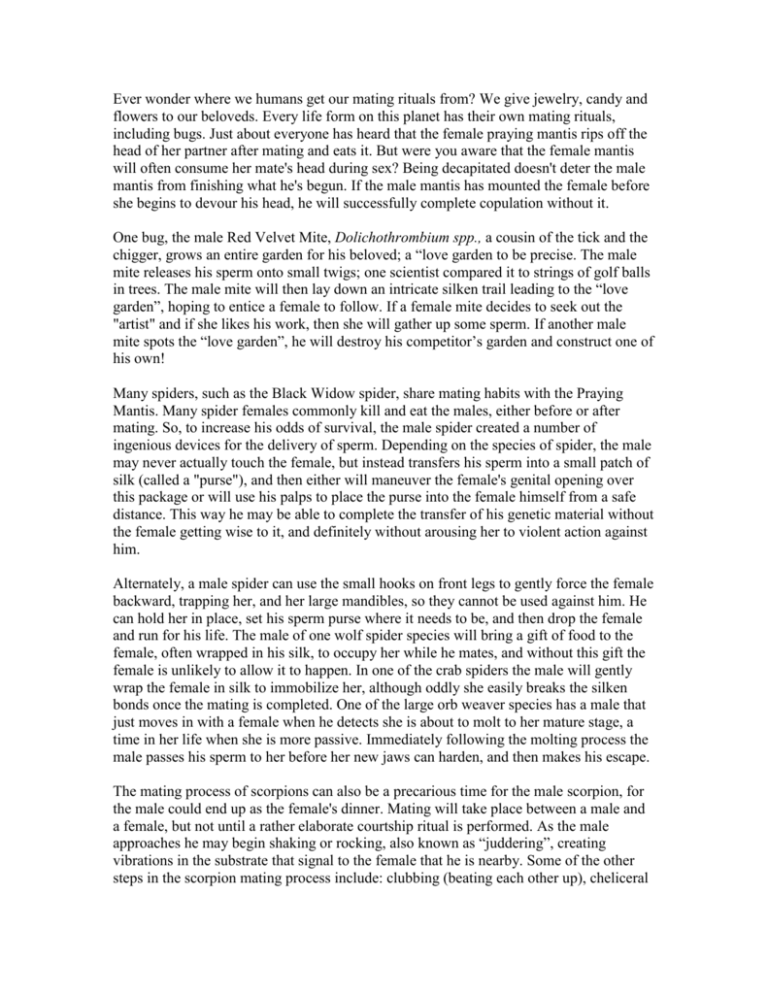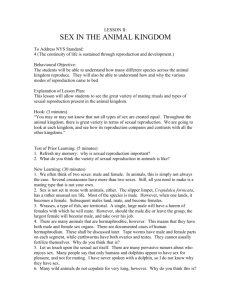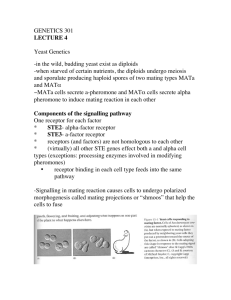The Secret Sex Lives of Insects
advertisement

Ever wonder where we humans get our mating rituals from? We give jewelry, candy and flowers to our beloveds. Every life form on this planet has their own mating rituals, including bugs. Just about everyone has heard that the female praying mantis rips off the head of her partner after mating and eats it. But were you aware that the female mantis will often consume her mate's head during sex? Being decapitated doesn't deter the male mantis from finishing what he's begun. If the male mantis has mounted the female before she begins to devour his head, he will successfully complete copulation without it. One bug, the male Red Velvet Mite, Dolichothrombium spp., a cousin of the tick and the chigger, grows an entire garden for his beloved; a “love garden to be precise. The male mite releases his sperm onto small twigs; one scientist compared it to strings of golf balls in trees. The male mite will then lay down an intricate silken trail leading to the “love garden”, hoping to entice a female to follow. If a female mite decides to seek out the "artist" and if she likes his work, then she will gather up some sperm. If another male mite spots the “love garden”, he will destroy his competitor’s garden and construct one of his own! Many spiders, such as the Black Widow spider, share mating habits with the Praying Mantis. Many spider females commonly kill and eat the males, either before or after mating. So, to increase his odds of survival, the male spider created a number of ingenious devices for the delivery of sperm. Depending on the species of spider, the male may never actually touch the female, but instead transfers his sperm into a small patch of silk (called a "purse"), and then either will maneuver the female's genital opening over this package or will use his palps to place the purse into the female himself from a safe distance. This way he may be able to complete the transfer of his genetic material without the female getting wise to it, and definitely without arousing her to violent action against him. Alternately, a male spider can use the small hooks on front legs to gently force the female backward, trapping her, and her large mandibles, so they cannot be used against him. He can hold her in place, set his sperm purse where it needs to be, and then drop the female and run for his life. The male of one wolf spider species will bring a gift of food to the female, often wrapped in his silk, to occupy her while he mates, and without this gift the female is unlikely to allow it to happen. In one of the crab spiders the male will gently wrap the female in silk to immobilize her, although oddly she easily breaks the silken bonds once the mating is completed. One of the large orb weaver species has a male that just moves in with a female when he detects she is about to molt to her mature stage, a time in her life when she is more passive. Immediately following the molting process the male passes his sperm to her before her new jaws can harden, and then makes his escape. The mating process of scorpions can also be a precarious time for the male scorpion, for the male could end up as the female's dinner. Mating will take place between a male and a female, but not until a rather elaborate courtship ritual is performed. As the male approaches he may begin shaking or rocking, also known as “juddering”, creating vibrations in the substrate that signal to the female that he is nearby. Some of the other steps in the scorpion mating process include: clubbing (beating each other up), cheliceral massage (bug kissing), promenade a deux (dancing) and the all important - post-mating escape. The reproductive cycle of bees is just as fascinating – and complex. A virgin queen that survives to adulthood without being killed by her rivals will take a mating flight with a dozen or so male drones (out of the thousands of eligible bachelors in the colony). Being selected is a mixed blessing for the drones. Yes, these drones may get the opportunity to propogate the next generation of bees, but this priviledge comes at a price. During mating, the drones’ genitals explode and snap off inside the queen! Fatal as it is, this makes evolutionary sense: the snapped-off penis acts as a plug to prevent other drones from fertilizing the queen. The male bedbugs don’t even bother with the female’s sex organs. Instead, a male bedbug uses its scimitar-like sexual organ to impale the female bedbug’s body and deposit his sperm! Scientists even have a name for this action: "traumatic insemination." No kidding! The title of world’s longest sperm actually belongs to a tiny fruit fly called Drosophila bifurca. When the coiled sperm is straightened out, it measures about 2 inches which is over 1,000 times longer than a human sperm. In fact, the testes of a fruit fly makes up 11 percent of the body mass of the male! The very long sperm evolved due to the just-aslong female reproductive tract, which is like an obstacle course, complete with harsh chemicals to weed out weak sperm. One of the oddest practices in the mating world belongs to a breed of fly. Its technical name is Serromyia femorata, a type of biting midge. The flies take up a position during mating which resembles kissing. Afterwards, the female midge sucks ALL the body fluid out of the male through his mouth. Thankfully, we humans have kinder, gentler versions of these mating rituals. We give each other presents, and dance ‘til the wee hours of the morning. After learning about these few insect mating practices, my husband was much happier to buy some jewelry this Valentine’s Day. There’s less chance of anything exploding, becoming impaled or getting ripped off and eaten.







